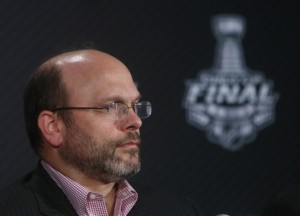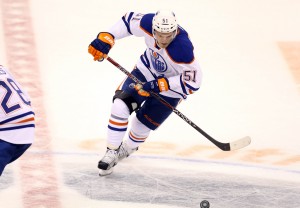Rome wasn’t built in a day. It’s tired. It’s over-used. It’s outstandingly accurate. As clichéd as the idiom has become it’s a lesson we should pay attention to. It’s a lesson Kevin Lowe should have paid attention to, and one Oilers fans can only hope Peter Chiarelli has learned.

The Oilers are benefiting from bailouts
Peter Chiarelli has been handed the key to a business in disrepair. He’s been given a few executives and an incredible salesman and was told to fix it. The problem is: that’s not how you fix a business. Imagine the Edmonton Oilers as a business and the NHL draft as a bailout. Each year, for the past six years, the Oilers get a top end prospect – or in our case a bailout – hoping to revitalize the team and bring about changes.
The problem is that these bailouts are money thrown into a sinking business. If the draft lottery is a bailout then the Oilers are General Motors and that eleven billion dollar deficit isn’t going anywhere. So then what’s the answer? Well according to lady luck its more bailouts. It’s a clean slate with a cool 97 million dollars on the way this summer; but what’s that going to solve?
Edmonton has mastered the top ten pick, mainly because they rarely need to do much scouting on the prospects. Like a bailout these talents were handed to them and expected to change the future of the organization.
The Oilers were gifted Taylor Hall, the highest point-per-game player from his draft year and eighth in the league at even strength since the 2011-2012 season. That’s on top of Jordan Eberle and Ryan Nugent-Hopkins. It’s a first line that is the crux of any other team, but instead the Oilers are once again in the bottom five of the league. These bailouts only treat the symptom; if the Oilers are to truly improve what they need to do is cure the problem.

Dealing with dismal drafting
That brings me back to draft. What has been their worst nightmare could also be their saving grace. The Edmonton Oilers don’t have a glowing history when it comes to drafting over the last decade. In fact since 2005 they’ve only drafted four players outside of the first round that have played at least 100 games in the NHL. Of those four players, only three are active. If you break that down even further, one was press-box connoisseur Jeff Petry, now of the Montreal Canadiens. The second is Chris Vandevelde, a Flyers depth center, and the other is Anton Lander. He is a bottom nine player on a good day and the only one still with the franchise.
For comparisons sake the Los Angeles Kings have drafted nine players in that time period (and it will be ten once Tanner Pearson hits the century mark). Those players include Jonathan Quick, Tyler Toffoli, Slava Voynov, Wayne Simmonds (who would eventually become Mike Richards) and Dwight King.
It’s not just the Kings either, in the past decade the Red Wings have drafted Gustav Nyquist, Tomas Tatar, Tomas Jurco, Darren Helm, Joakim Anderson, Justin Abdelkader and Shawn Matthias all outside of the first round. Nick Hjalmarsson, Brandon Saad and Andrew Shaw are just headlines on the list of players the Blackhawks have drafted outside of the first round. The list goes on. In fact, it’s hard to look at any Stanley Cup contender in the NHL and not see a glowing review of their scouting; which begs the question: why isn’t more focus placed on the Oilers draft record?
Maybe it’s because the average NHL team has only drafted five players with 100+ games played over that time span to their four. Maybe it’s because of those five players only four remain active. Maybe it’s because relative to the rest of the NHL the Oilers aren’t doing that bad. But comparing yourself to teams that haven’t won either isn’t the comparison Peter Chiarelli should make.
A model to follow
Instead let’s look at their numbers compared with the teams that won the Stanley Cup over that same ten-year time span. In that time frame 7 different teams have won the cup. They have drafted on average 7 players after the first round that have played at least 100 NHL games, and of those, 6 are still active. Suddenly the Oilers draft history sticks out. Their drafting success is nearly half the rate of Cup winners and it shows in the standings. Without the depth talent for their second, third, and even fourth lines the Oilers don’t have the necessary pieces to contend with giants of the NHL.

It’s not just the bodies on these lists either. It’s the names attached to them. The Blackhawks aren’t drafting just anybody and getting lucky in the later rounds. They’re picking drivers. Guys like Andrew Shaw, Brandon Saad, and Marcus Kruger. Players who excel in a role where they aren’t relied on for scoring but can bring the fundamental skills necessary to compete at the NHL level.
These are players who are rarely found in the off-season. These types of guys are usually loyal to their team and in return the team is loyal to them. They probably won’t make the first line but they give their coach the ability to reliably roll four lines and not worry about defensive liabilities. Without the talent found in the depths of the draft an NHL team simply cannot succeed. No one superstar can consistently make up an entire teams depth scoring, just ask Sidney Crosby.
The next step
Which brings us back to the Oilers. With a myriad of top end talent, and a generational player on the way Peter Chiarelli’s biggest focus needs to be how he can make his business thrive, and lose that 11 billion dollar deficit without relying on more buyouts. Proven winners in the NHL have a scouting system that keeps the cupboards full. If the Oilers are going to compete they will need some changes to their draft policies ahead of this year’s NHL Entry Draft.